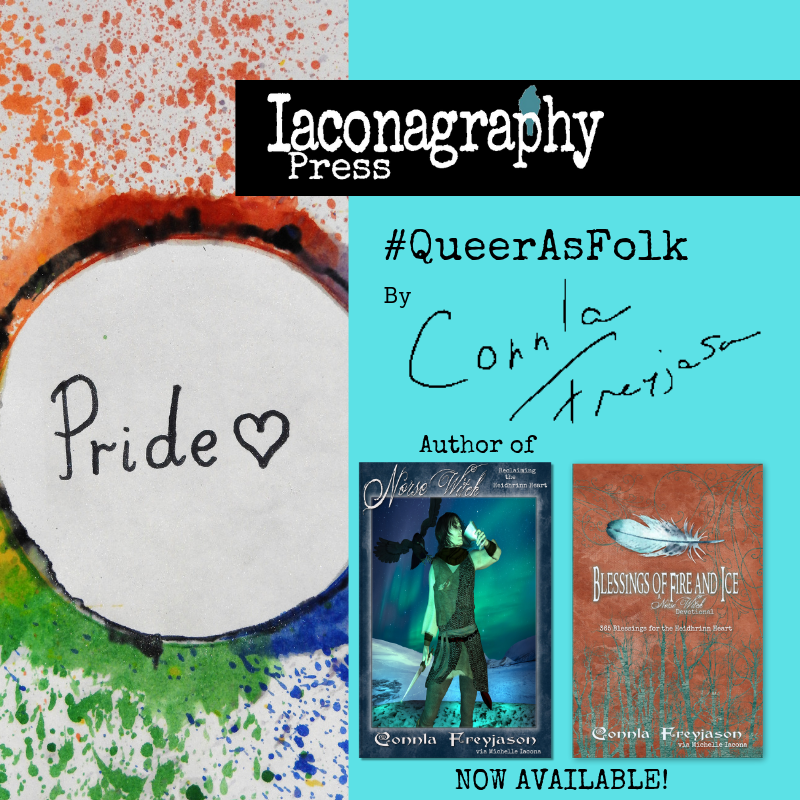Queer As Folk

The sun was warm, the whistles were loud, and the parade route was literally uphill both ways. I looked out across the sea of gathered faces–a multi-colored crowd, and not only because rainbows were everywhere–and raised my staff to hail them, as a Vitki might have done in days of yore. As I walked, panting from the heat and the blisters slowly growing on my feet, my mind rolled with a pair of mantras that I still cannot shake: “Ergi is as ergi does”…”We are queer as Folk.”
Ergi is as ergi does. “Ergi”: it has become an ancient word used by modern people to malign those who are Many-Lettered (LGBTQ+). It is all done “innocently”, of course, or at least that’s the “paint” they use, to try and hide their bigotry. Yet for those who find the word hurled in their general direction, its intent is crystal clear: “you don’t belong here; we don’t want you”. Most of the time, when the topic comes up, people are armed and ready with the passage from Lokasenna 24:
En þik síða kóðu Sámseyu í,
ok draptu á vétt sem völur;
vitka líki fórtu verþjóð yfir,
ok hugða ek þat args aðal.
But you reform utterances in a Saami island,
And beat on a vétt (drum? lid? shield? box?) like the seeresses;
In the form of a vitki you journeyed mankind over,
And I thought that unmanly (also effeminate, lewd, cowardly, wicked, or pernicious) in nature.
—Lokasenna 24, Connla Freyjason Translation
Obviously, the word in that passage is actually args, not ergi, but the two are generally translated as synonyms. The speaker here, of course, is Loki, speaking to Odin. If ever there was someone who lived in a glass house and shouldn’t throw anti-LGBTQ+-rocks, it is The Trickster Himself! In truth, if we take a closer look at those words–args, argr, and ergi–we find the following Old Norse definitions:
“unmanly, cowardly, wicked, lewd, pernicious, effeminate, lustful”
In other words, a host of words that, when taken together, mean “behaving contrary to personal authenticity“. To be args/argr/ergi, originally (as in: before the onslaught of Christianity) meant to stand outside one’s own power; to lack Sovereignty. All of those connotations of effeminacy and receptive homosexuality? Yeah, those were just medieval attempts at illustrating the concept of giving away one’s own power.
So, when we effectively slam the door in someone’s face by calling them ergi, we are taking away that power. When we make them feel as though they should shove themselves back into whatever closet they are feverishly attempting to burst out of, we are likewise forcing them to give away that power.
Ergi is as ergi does: stand in your own power; be loud, be proud, be beautiful; above all, be authentic. Claim and proclaim your LGBTQ+ Sovereignty; bang that drum; take that journey; raise that staff! Come out of that closet and fly your colors: you will only be truly ergi if you keep that door firmly locked.
We are queer as Folk. Folkishness in Heathenry has been the source of a wide variety of evils, from outright racism, to sexism, to genderism. Sure, it’s often dressed up in the very polite language of “attempting to overthrow cultural appropriation” and “celebrate ancestral (DNA-provable) heritage”, but when all is said and done, the ugliness is (hopefully) as clear as the mustache on Hitler’s tight-screwed face. In Iron Age Scandinavia, however, folk meant something completely different than it does today: it meant the people that composed a person’s primary sphere of interaction (see Joseph Campbell’s work on peer polities and interaction spheres); it didn’t just mean blood, it meant community. Within that community, there were clearly those who did not subscribe to what today are defined as “common gender norms”, yet those people were celebrated. How do we know? Because they were given elite burials in a time where well over half the population received no form of monumental burial whatsoever (Price, 2008). In our modern world, the folkish regime has taken it upon themselves to spit on those who refuse to “be fruitful and multiply” (code for “make more white babies”), including those within the LGBTQ+ community, yet in Iron Age Scandinavia, the Many-Lettered were esteemed as warriors, mystics, and religious leaders. We desperately need to reclaim that tradition: We are queer as Folk.
Part of the celebration of Pride Month every year is to remember those who have gone before us, and blazed this trail; those who have flung open the closet, so that we do not have to remain locked inside. It is easy for us to do that, when it comes to those who have lived in our own modern times: the brave drag queens of Stonewall; Matthew Shepard; Anne Lister; even Oscar Wilde. Yet what of those of the ancient Scandinavian past (what is termed the pre-historic past in the field of archaeology)? They existed. While we must be very careful not to ascribe modern translations of gender roles onto ancient people, it is profoundly important that we remember these people who broke the “ordinary mold”, for #whatisrememberedlives.
Sigfinn: We cannot know the name of the person who was buried in Cremation Grave 94 at Valsgarde Gravefield in the 10th century, nor can we fully understand the scope of what it means that they were osteologically male, yet buried in a grave filled with female grave goods (Graslund, 2008). I have chosen the name Sigfinn because it’s what my heart tells me, and also because it is easier to develop genuine empathy with a name, instead of a numbered grave designation. (It means “Victorious Person of Saami-Descent” or “Victorious Wanderer”.) At the surface level, Sigfinn’s grave presented as a ring of stones, just north of that of another confirmed magickal practitioner: Valsgarde Cremation Grave 85. Within the ring were discovered two ceramic urns, one of which contained cremains, and atop which had been lain the uncremated remains of a chicken. Not all of the cremains within the urn were human: there were also those of a horse, a dog, a sheep, and a pig. Before cremation, Sigfinn was clearly richly equipped with jewelry, including a large pair of oval brooches which had previously been strung with carnelian, rock crystal, and glass, as well as a bronze amulet, and iron ear spoons. They had been equipped with a bronze needle-case, iron shears, a knife, and a whip mount, as well as crampons, indicative either of Otherworld travel (crampons are often associated with “Hel shoes”, the helskor mentioned in Gisla saga Surssonar 14; Price, 2002) or a winter burial (Graslund, 2008). The remains are conclusively osteologically male, even though the grave-goods would traditionally be classified as female. They were more than likely a practitioner of trolldomr.
Ergi is as ergi does. Live your LGBTQ+ Truth; our Ancestors apparently did! We are queer as Folk.
Living my life as a bisexual man was complicated, long before I found myself in a position where I needed to add “coming out of the coffin” to “coming out of the closet”. Now, living my life here in the mundane world channeled by a teeny, tiny, very gifted female, it’s really not easier. I walked that parade route on Saturday, and to the passersby, I was just another female-presenting person of undisclosed gender orientation. Yet I knew and I know who and what I am: a cis-gender male who identifies as bisexual. It’s not easy being this; it has never been easy being this. Yet I am proud of who and what I am, and I hope that if you are out there, reading this from the back of the closet, my very difficult admission can give you some courage; can give you some hope. Because I refuse to be ergi anymore, just to keep people comfortable and keep from ruffling any feathers, proverbial or otherwise. I am queer as Folk; maybe you are, too.



